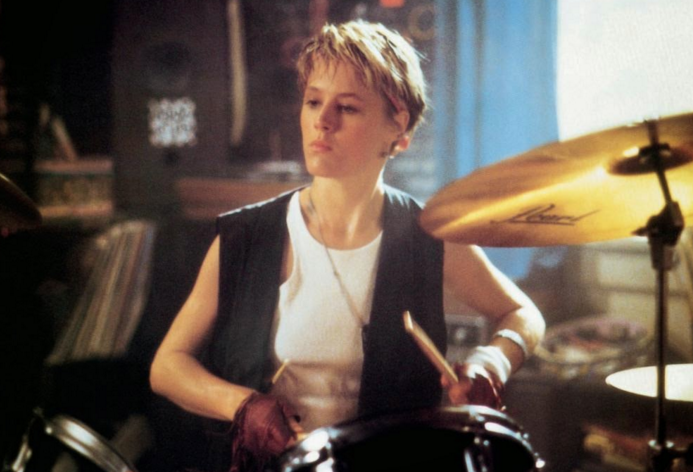Coinciding somewhat unfortunately with another John Hughes-related milestone–the death of Bill Paxton, legendary douchebag perfecter in the form of Chet from Weird Science–the thirtieth anniversary of Some Kind of Wonderful is upon us, with its original theatrical release date being February 27, 1987. Once again putting Howard Deutch in the director’s chair (as Hughes also did for Pretty in Pink, which celebrated its own thirtieth anniversary last year), Hughes blazed the trail of a highly modern topic: the often unwanted friend zone that occurs between men and women.
Never one to shy away from his usual themes of class division, Hughes’ protagonist, Keith Nelson (Eric Stoltz), is a “wrong side of the tracks” (even though, in this case, its setting in L.A. means there aren’t too many tracks to speak of) high school student who works as a mechanic. His best friend, Watts (Mary Stuart Masterson), suffers from the same socioeconomic standing that makes her equally as persona non grata at San Paolo High School (really, San Pedro High School). However, the girl that manages to “escape,” so to speak, from her blue collar background is Amanda Jones (Lea Thompson, who could only have managed to be a dream girl figure in the 80s). “Hot” and “normal” enough to blend in with the rich kid crowd, Amanda seems far out of Keith’s reaches–which, of course, only makes her more desirable. That, and that she’s just broken up with the requisite douchebag of the movie, Hardy Jenns (Craig Sheffer)–a really great name for an asshole. In a rapport that would mirror the one between Amanda (apparently it’s the name for popular and malleable girls) Beckett and Mike Dexter in Can’t Hardly Wait, Amanda realizes that she’s only in the relationship to swim with the proverbial social sea. This amount of layeredness in her character shows a strong evolution from Hughes’ popular girl antagonists of the past, e.g. Caroline (Haviland Morris), who always seemed content not to question the motives behind their existence too heavily.
Seizing his moment to ask Amanda out while she’s still single, Keith foolishly takes Watts up on her offer to practice his kissing technique on her, inevitably making Watts all the more jealous when Amanda ends up accepting Keith’s advances. Representing the classic archetype of the tomboy–except far more badass by virtue alone of playing the drums and making a chauffeur’s uniform somehow endlessly chic–Watts is the “friend girl” who can never seem to be seen in a sexual context by the object of her desire. Those she doesn’t desire, on the other hand, like Ray (Scott Coffey), another musician who’s too into her, are always accessible. Regardless of the fact that her male friend enjoys her company more and generally prefers the comfortableness of being around her, it still doesn’t manage to translate for the guy in question that the entire crux of a good relationship is friendship. Some Kind of Wonderful drives in this point often with the intensity of a stake into a vampire as Watts’ feelings intensify and she’s unable to do anything about them. And even though Keith, too, recognizes that there’s something more to their rapport than the platonic, he falls back on the natural daftness of being a man to avoid the emotions he intuits.
No longer wanting be a glutton for punishment, Watts delivers the now classic line to Keith, “The only things I care about in this goddamn life are me and my drums and you,” after insisting that they start seeing less of each other. This also addresses the rarely broached topic of how male-female friendships must suffer a guillotine cutoff when one or other of the friends finagles a significant other, for it simply wouldn’t be fair to the s/o otherwise.
But Hughes was never one for letting the underdog down in his plotlines, redirecting Keith and Watts back together via a very sentimental emblem of the film. Almost Guy De Maupassant in nature, Hughes relished the opportunity to wield jewelry–specifically earrings–as a classist symbol that eventually binds a couple together (the same occurred in The Breakfast Club with John Bender and Claire Standish). In Keith’s case, using his college savings to purchase these earrings for Amanda ends up having far more meaning to Watts when he gives them to her and says, “You look good wearing my future.” However, I can’t say I’d be too keen to get with Keith after he 1) made me help him pick out jewelry for his girlfriend and 2) made me act as his driver to cart him and his girlfriend around on a date before giving her said jewelry.
Nonetheless, the union of two friends never made for a happier ending than in this film. Before Harry and Sally in When Harry Met Sally, before Ross and Rachel in Friends and before Dawson and Joey in Dawson’s Creek, there was Keith and Watts in Some Kind of Wonderful–still the most heartrending and honest portrait of what it’s like when one starts to get feels for a friend that might not necessarily be reciprocated. Admittedly, these tropes always focus on the heteronormativeness of opposite sex friendships–quite possibly because gay men and lesbians don’t ever beat around the bush when they want to boink (that beautiful 80s slang word for fuck).






















